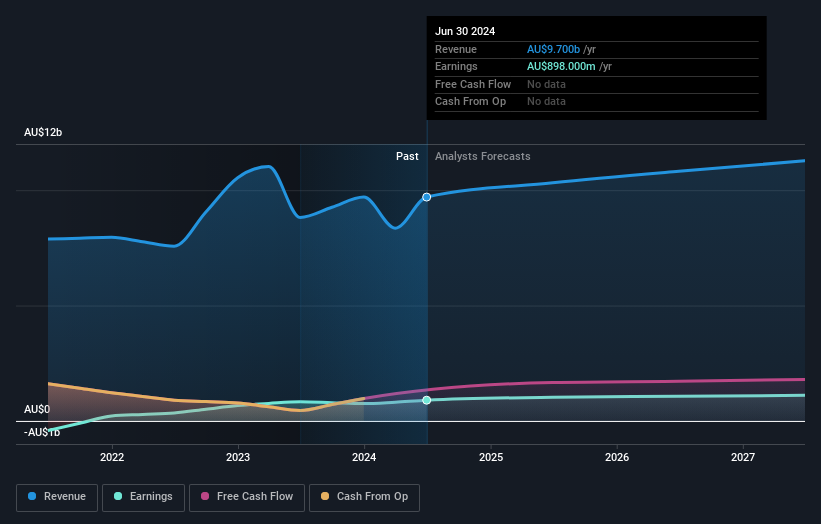Insurance Australia Group Limited Just Missed Earnings - But Analysts Have Updated Their Models

As you might know, Insurance Australia Group Limited (ASX:IAG) recently reported its annual numbers. It was a pretty mixed result, with revenues beating expectations to hit AU$9.7b. Statutory earnings fell 5.1% short of analyst forecasts, reaching AU$0.36 per share. The analysts typically update their forecasts at each earnings report, and we can judge from their estimates whether their view of the company has changed or if there are any new concerns to be aware of. So we collected the latest post-earnings statutory consensus estimates to see what could be in store for next year.
View our latest analysis for Insurance Australia Group

Taking into account the latest results, the most recent consensus for Insurance Australia Group from eleven analysts is for revenues of AU$10.3b in 2025. If met, it would imply a reasonable 6.4% increase on its revenue over the past 12 months. In the lead-up to this report, the analysts had been modelling revenues of AU$10.1b and earnings per share (EPS) of AU$0.42 in 2025. The thing that stands out most is that, while there's been a modest lift to revenue estimates, the consensus no longer provides an EPS estimate. This impliesthat revenue is more important following the latest results.
We'd also point out that thatthe analysts have made no major changes to their price target of AU$7.29. Fixating on a single price target can be unwise though, since the consensus target is effectively the average of analyst price targets. As a result, some investors like to look at the range of estimates to see if there are any diverging opinions on the company's valuation. There are some variant perceptions on Insurance Australia Group, with the most bullish analyst valuing it at AU$8.25 and the most bearish at AU$6.15 per share. Even so, with a relatively close grouping of estimates, it looks like the analysts are quite confident in their valuations, suggesting Insurance Australia Group is an easy business to forecast or the the analysts are all using similar assumptions.
Looking at the bigger picture now, one of the ways we can make sense of these forecasts is to see how they measure up against both past performance and industry growth estimates. The period to the end of 2025 brings more of the same, according to the analysts, with revenue forecast to display 6.4% growth on an annualised basis. That is in line with its 5.8% annual growth over the past five years. By contrast, our data suggests that other companies (with analyst coverage) in a similar industry are forecast to see their revenues grow 2.6% per year. So it's pretty clear that Insurance Australia Group is forecast to grow substantially faster than its industry.
The Bottom Line
The highlight for us was that the analysts increased their revenue forecasts for Insurance Australia Group next year. Happily, they also upgraded their revenue estimates, and are forecasting them to grow faster than the wider industry. There was no real change to the consensus price target, suggesting that the intrinsic value of the business has not undergone any major changes with the latest estimates.
We have estimates for Insurance Australia Group from its eleven analysts out to 2027, and you can see them free on our platform here.
That said, it's still necessary to consider the ever-present spectre of investment risk. We've identified 1 warning sign with Insurance Australia Group , and understanding it should be part of your investment process.
If you're looking to trade Insurance Australia Group, open an account with the lowest-cost platform trusted by professionals, Interactive Brokers.
With clients in over 200 countries and territories, and access to 160 markets, IBKR lets you trade stocks, options, futures, forex, bonds and funds from a single integrated account.
Enjoy no hidden fees, no account minimums, and FX conversion rates as low as 0.03%, far better than what most brokers offer.
Sponsored ContentNew: AI Stock Screener & Alerts
Our new AI Stock Screener scans the market every day to uncover opportunities.
• Dividend Powerhouses (3%+ Yield)
• Undervalued Small Caps with Insider Buying
• High growth Tech and AI Companies
Or build your own from over 50 metrics.
Have feedback on this article? Concerned about the content? Get in touch with us directly. Alternatively, email editorial-team (at) simplywallst.com.
This article by Simply Wall St is general in nature. We provide commentary based on historical data and analyst forecasts only using an unbiased methodology and our articles are not intended to be financial advice. It does not constitute a recommendation to buy or sell any stock, and does not take account of your objectives, or your financial situation. We aim to bring you long-term focused analysis driven by fundamental data. Note that our analysis may not factor in the latest price-sensitive company announcements or qualitative material. Simply Wall St has no position in any stocks mentioned.
About ASX:IAG
Insurance Australia Group
Insurance Australia Group Limited underwrites general insurance products and provides investment management services in Australia and New Zealand.
Solid track record with excellent balance sheet.
Similar Companies
Market Insights
Community Narratives



